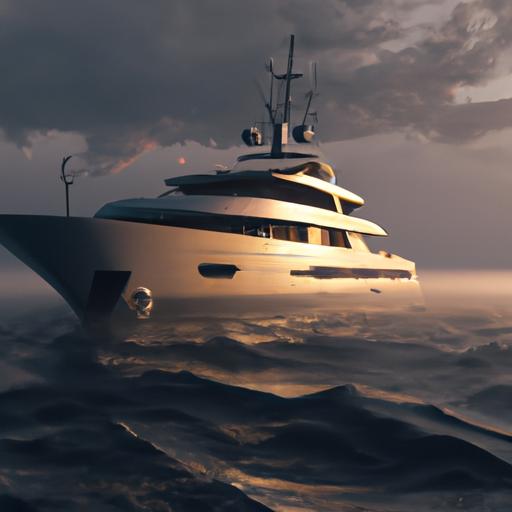When planning a luxurious yacht trip, the last thing on your mind may be rough seas.
But is your superyacht prepared if you encounter severe weather conditions? Can you trust it to keep you safe? In this article, we’ll dive into the world of superyachts and explore whether they can handle rough seas.
We’ll look at the benefits of stabilizers, advanced navigation systems, and weather forecasting, as well as tips to help you navigate rough waters when needed.
Read on to find out how your superyacht can handle rough seas.
Table of Contents
Short Answer
Yes, superyachts are designed to be able to handle rough seas.
They are usually equipped with stabilizers to reduce rolling and pitching, and often have reinforced hulls to withstand more extreme conditions.
Superyachts also have powerful engines to help them navigate through choppy waters.
However, even with these features, it is important for the captain to assess the sea conditions and take the necessary precautions to ensure the safety of everyone onboard.
What Are Superyachts?
Superyachts are luxury vessels that offer the ultimate in comfort and luxury.
They are typically much larger than traditional yachts, ranging in size from around 30 to 180 meters.
They come equipped with all the latest amenities, including sumptuous staterooms, spas, gourmet kitchens, and lounges.
Superyachts also have a range of technological features, such as advanced stabilization systems, navigation systems, and entertainment systems.
They are often the preferred choice for those looking for the ultimate in luxury and comfort while at sea.
Are Superyachts Built for Rough Seas?

No matter how luxurious and popular they may be, superyachts are not built for rough seas.
While their design and construction can handle choppy waters and high winds, they are not designed to handle extreme weather conditions.
That said, with the right preparation and caution, superyachts can handle rough seas and still provide a comfortable and luxurious experience.
Superyachts are equipped with stabilizers to reduce rocking and rolling in the waves.
These stabilizers act as shock absorbers, dampening the effect of the waves and helping to keep the vessel steady.
Stabilizers also help to maintain the vessels course in choppy waters, reducing the risk of it veering off course.
In addition, superyachts feature advanced navigation systems to help them stay on course.
These systems use GPS and other technologies to monitor the vessels position and track its progress through the waters.
This allows the vessels captain to stay aware of their surroundings and adjust their course accordingly.
Finally, its important to note that preparing for a voyage in rough seas involves more than just the vessel itself.
The crew should be properly trained and equipped to handle any situation that may arise, and the vessel should be stocked with enough supplies to get it through the voyage.
In addition, the captain should be familiar with the local weather conditions and the potential risks associated with the voyage.
Overall, while superyachts may not be built for rough seas, they can handle choppy waters and high winds with the proper preparation and caution.
With the right equipment and training, superyachts can provide a comfortable and luxurious experience even in the roughest of waters.
The Benefits of Stabilizers
When it comes to handling rough seas, superyachts are equipped with a variety of features that can help them stay on course and provide a comfortable and luxurious experience.
One of the most important features is the stabilizers, which are specially designed to reduce rocking and rolling in the waves.
These stabilizers are designed to provide the vessel with a more stable platform in choppy waters, which is essential for keeping passengers and crew safe.
Additionally, stabilizers help to minimize the fatigue of the crew, which is important during long trips.
Furthermore, stabilizers can also help the vessel conserve fuel, as they reduce drag and make the boat more efficient.
Ultimately, stabilizers are an essential feature for superyachts and can make a big difference when it comes to handling rough seas.
Maneuverability and Advanced Navigation Systems

When it comes to navigating rough seas, superyachts are equipped with advanced maneuverability and navigation systems.
These systems include powerful engines and sophisticated hydrodynamic hull designs, allowing the vessel to move quickly and efficiently through the water.
The ability to maneuver quickly and precisely is essential when navigating through rough waters, as it allows the yacht to avoid obstacles and potentially dangerous conditions.
Additionally, many superyachts are equipped with advanced navigation systems, such as GPS and radar, which allow for precise plotting of courses and help to avoid hazards.
With these navigation systems, the captain can keep track of the yacht’s progress and make adjustments as needed.
By using these tools, superyachts can make their way through rough seas with ease.
Taking Precautions in Rough Seas
When it comes to navigating rough seas aboard a superyacht, it is important to take the necessary precautions.
Before setting out, it is best to check the weather forecast and plan the route accordingly.
If the seas are too rough for a particular area, a different route should be chosen.
Additionally, the crew should be prepared with the necessary safety gear, as well as emergency plans in case of an accident.
It is also important to pay attention to the vessel’s performance and watch for any signs of trouble.
This includes monitoring the fuel levels, engine performance, and the overall movement of the yacht.
If anything appears to be off, the captain should take the necessary steps to prevent further damage.
Finally, it is important to remain vigilant while navigating the rough seas.
Passengers should stay indoors and away from railings and other items that may become unstable in high winds or choppy waters.
The crew should also constantly monitor the yacht and be prepared to take action if necessary.
By taking these precautions, the crew and passengers can stay safe and enjoy a comfortable and luxurious experience despite the rough seas.
The Benefits of Weather Forecasting

When it comes to handling rough seas, having access to accurate weather forecasting is essential.
With the right forecasting tools, captains can plan their journeys in advance, taking into account wind speed and direction, wave heights, and other pertinent information.
Weather forecasting can help captains plan their routes and make decisions on when to sail or when to stay in port.
It can also give them the opportunity to avoid weather systems that are too dangerous for their superyacht to handle.
By staying informed on the weather, captains can ensure that their superyacht is able to handle rough seas in a safe and comfortable manner.
Tips for Handling Rough Seas
When it comes to navigating rough seas, preparation is key.
The first step is to plan ahead and check the weather conditions before you set out.
This will give you an idea of what to expect and allow you to prepare your superyacht accordingly.
If the forecast calls for rough seas, youll want to make sure that your vessel is equipped with the necessary safety features and that your crew is properly trained.
Equipping your superyacht with stabilizers is essential for handling rough seas.
Stabilizers reduce rocking and rolling in the waves, allowing you to remain comfortable even in choppy waters.
Additionally, you should ensure that your navigation system is up-to-date and that your crew is familiar with its use.
This will help you to stay on course and avoid any potential hazards.
When the seas get rough, its important to take extra precautions to ensure the safety of your vessel and its passengers.
Make sure to keep an eye out for any debris in the water and to stay away from shallow waters.
You should also avoid making sharp turns and maintain a steady speed.
Allowing your superyacht to naturally move with the waves is also a great way to minimize the effects of choppy waters.
Finally, its important to remember that the luxury of a superyacht should never come at the expense of safety.
If the conditions become too severe, its always best to take shelter until the weather clears.
With the proper precautions and preparation, superyachts can handle rough seas and still provide a comfortable and luxurious experience.
Final Thoughts
Superyachts are luxurious vessels that are not built for rough seas, but can handle high winds and choppy waters with proper preparation.
With stabilizers to reduce rocking and rolling, advanced navigation systems to stay on course, and the proper caution and preparation, superyachts can handle rough seas and still provide a comfortable and luxurious experience.
If you’re ever planning to take a superyacht out in rough seas, it’s important to be aware of the risks, take the necessary precautions, and stay up to date on weather forecasts.
With the right measures in place, you can make sure that your superyacht can handle rough seas and still provide an enjoyable and luxurious experience.

